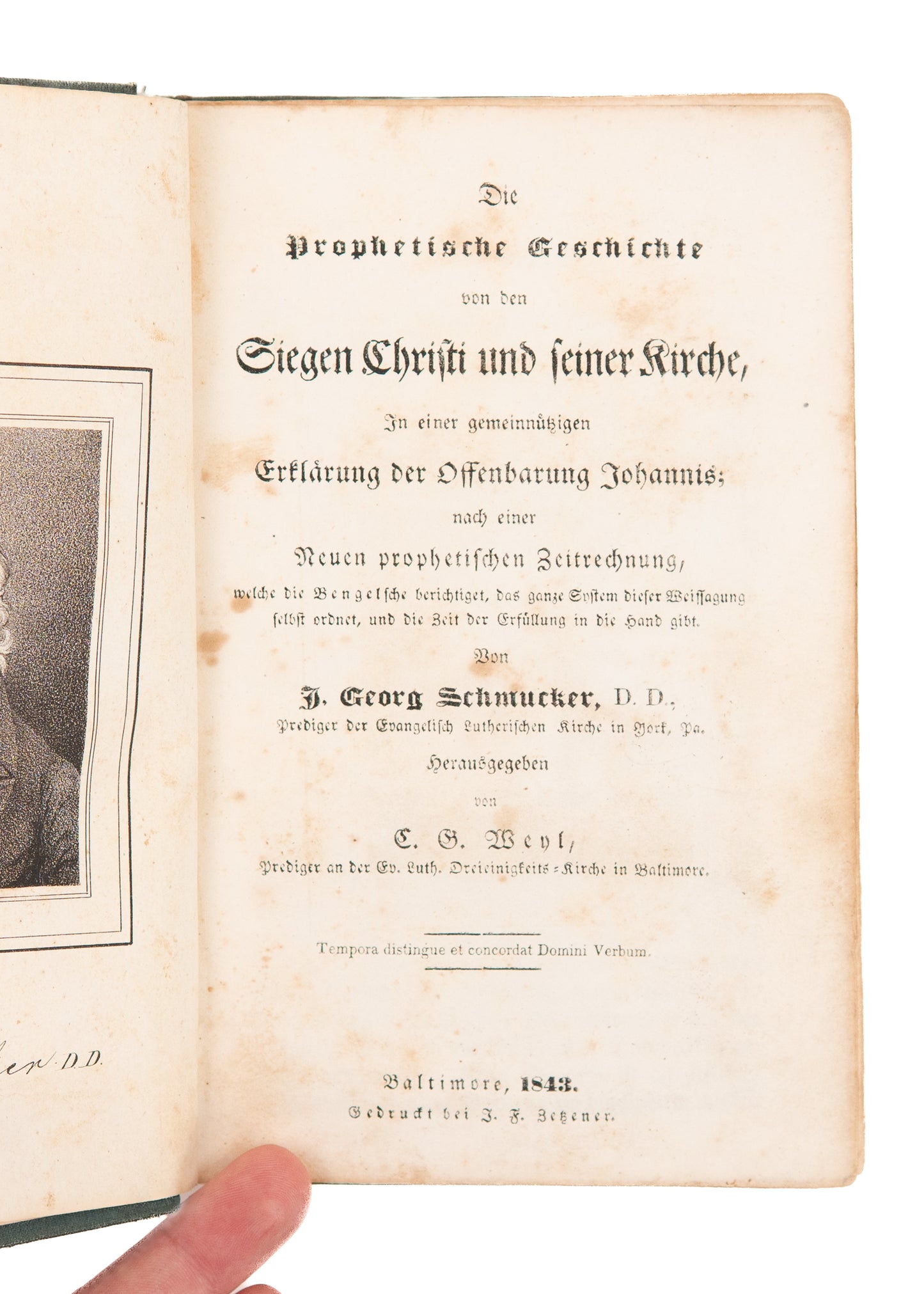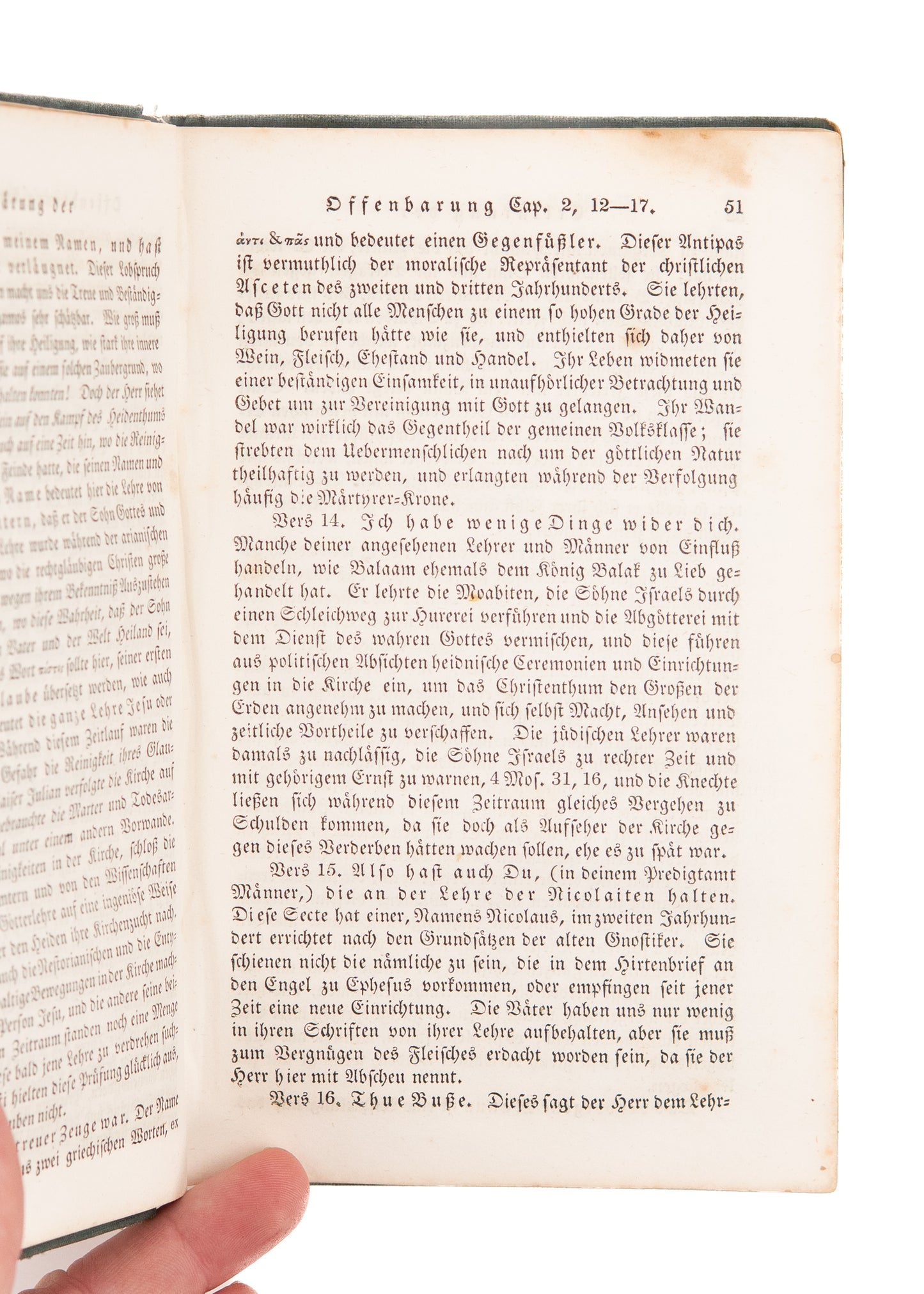Specs Fine Books
1843 SECOND ADVENT. Rare German Adventist Work Issued in America in the Year of Miller's Prediction.
1843 SECOND ADVENT. Rare German Adventist Work Issued in America in the Year of Miller's Prediction.
Couldn't load pickup availability
Rather rare first edition of John George Schmucker's excellent Millennialist / Adventist work issued in 1843, complete with expansive fold-out chart, etc., Schmucker is recalled as having been representative and influential in the Millennialist strain of the B
Born in 1771, in 1785 the family emigrated to the United States, finally locating permanently in the area of Woodstock, Virginia. He began his ministerial studies in 1789 under the noted theologian and missionary, the Reverend Paul Henkel of New Market, Virginia. Immediately influential, he was elected to the presidency of the Ministerium several times, and served the Ministerium in a number of other capacities. He took a significant leadership role (along with his son, Samuel) in the founding of the General Synod (1820) and the seminary at Gettysburg (1826). He edited Lutherische Magazin, authored articles, and published several books.
Among his books, the most significant is his commentary on the Revelation of Saint John, offered here, which was published in German. The full title in English translation reads The Prophetic History of the Christian Religion Explained, or, A Brief Exposition of the Revelation of St. John :According to a New Discovery of Prophetical Time: By Which the Whole Chain of Prophecies Is Arranged, and Their Certain Completion Proved from History Down to the Present Period: With Summary Views of Those not Yet Accomplished.
Schmucker's conviction of the near coming of Jesus provided the impetus for his eschatological work. With the tumultuous events of the French Revolution and Napoleon, along with his belief that the Order of the Illuminati were running world affairs, providing the immediate context, Schmucker observed that "So corrupted is the present state of the world; so panting the vitiated heart of man for liberty, to follow its depraved inclinations without restraint or remorse . . . the christian world has arrived at a very portentous period, full of great and alarming events . . . the end of the present form of civil and ecclesiastical economy is near."
While recognizing that he is in a long line of interpreters of the Revelation of Saint John, Schmucker notes that older explanations were necessarily in error due to the fact that "the signs of the times had not yet appeared." Thus what sets Schmucker's work apart, in his mind, is the fact that it appears at the due time; that moment in prophetic history when the historic prophecies have been fulfilled and their interpretation has become clear. Schmucker anticipates the criticism of certain interpreters who would adduce the words of Jesus, "But of that day and hour knoweth no man." He argues that the words of the Lord in this respect do not refer to the second advent of Christ, but instead to the end of the world. These two events will be separated by the glorious millennium, and therefore, it is possible, with the appropriate prophetic hermeneutic, to determine the timing of Christ's return, though not the end.
The unique contribution, then, of Sclunucker's work is his prophetic chronology, which will reveal the very year during which the Lord's second advent will occur. In this endeavor Schmucker is in no way alone. In fact, his perspective is in large part driven by the work of Bengel. Bengel's widely accepted chronology provided Schmucker with the authority to produce his own. In Sclunucker's mind, Bengel has rightly pointed to chapter thirteen as the chronological key to the book. Where other exegetes of the Apocalypse have taken "a day in the Revelation to signify a year," Schmucker follows Bengel in distinguishing between "prophetic time" and "natural" or "common time."
Verse five of chapter thirteen (the forty-two weeks) speaks of prophetic time, while verse eighteen (the 666) refers to natural or common time. In other words, "if forty-two months give six hundred and sixty-six lunar years" then we can calculate exactly the length of a prophetic hour, day, week, month, and year (666 years of natural time equal forty-two months of prophetic time).
Again, Schmucker criticizes his predecessors, noting that they have proceeded from an erroneous date, namely AD. 96, the time of John's writing of the Revelation. In fact, argues Schmucker, the proper date is A.D. 72, the year of the destruction of Jerusalem. At this point we already anticipate an error in Schmucker's calculations, given that he has the date of the destruction wrong. But he offers a disclaimer of sorts, arguing that, given the fact that our calendars are of some little inconsistency among themselves, and, therefore, his calculations could be from six to ten years off. That, however, does not stop Schmucker from adducing a date for the return of Christ: 1850.
Schmucker, Johann Georg. Die Prophetische Geschichte von den Siegen Christi und Seiner Kirche : in einer Gemeinnützigen Erklär ung der Offenbarung Johannis ; Nach Einer Neuen Prophetischen Zeitrechnung, Welche die Bengelsche Berichtiget, das ganze System Dieser Weissagung Selbst Ordnet, und die Zeit der Erfhullung in die Hand Gibt. Bon J. Georg Schmucker, D. D., Prediger Der Evangilch Lutherichen Kirche in Morf, Pa. Herausgegeben von C. B. Benl, Prediger an der ev. Luth. Dreieinigfeits = Rirche in Baltimore. Tempora distingue et concordat Domini Verbum. Baltimore. Dedrudtbei J. F. Bekener. 1843. 347pp.
A good copy, bound in cloth, lightly shaken, with handled pages, and light to moderate foxing.
Share














